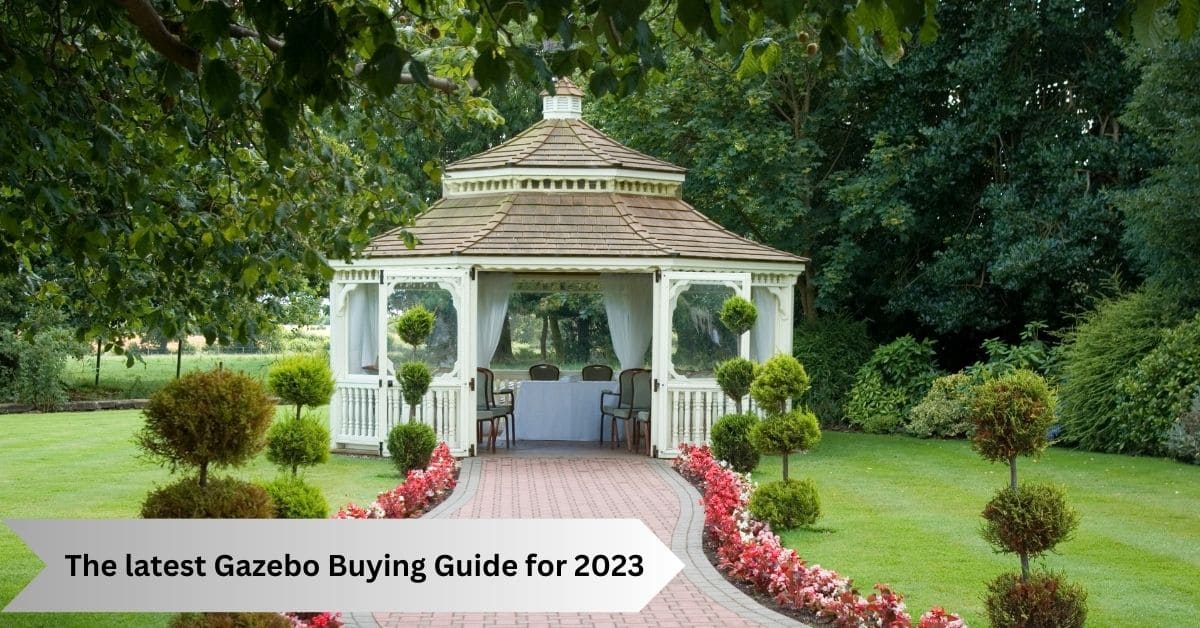When it comes to selecting and buying a gazebo, there are many important factors to consider. A gazebo buying guide can help you navigate the options and make an informed decision based on your specific needs and preferences.
Some key considerations include the type of gazebo, the materials used in construction, size and shape, optional features, and maintenance and care.
Additionally, budget considerations are important, as gazebos can range in cost depending on the type, materials, and features. Using a gazebo buying guide, you can make a well-informed decision and choose a gazebo that best suits your lifestyle and outdoor space.
What Is a Gazebo? The latest Gazebo Buying Guide
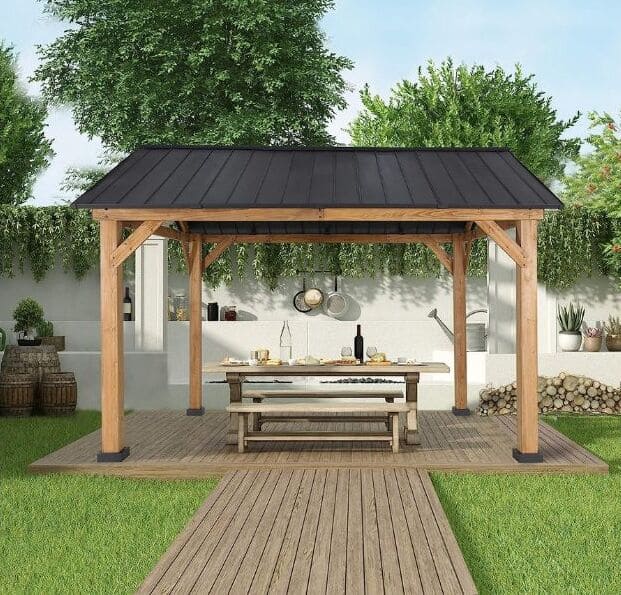
A gazebo is a covered outdoor structure that can be placed in your backyard, patio, or garden. It comes in different shapes and sizes to fit your outdoor space.
Gazebos are made of metal or wood and often have built-in seating. Some gazebos have curtains or latticework for added privacy.
You can put furniture or a hot tub inside and enjoy the view while staying protected from the sun and rain. A gazebo provides a shady and private spot where you can relax with your friends or by yourself.
Benefits of Having a Gazebo
A gazebo is a great way to spend time outside, whether it’s summer or winter. If you like being in your garden or reading in a peaceful area, a gazebo is perfect for you. It gives you a comfortable place to sit and enjoy the outdoors, even if it’s raining or sunny.
You can relax and read, listen to music, or enjoy nature, all while staying protected from the weather.
Tips for Choosing the Right Gazebo
When selecting a gazebo for your outdoor space, there are several factors to consider to ensure that you choose the best one for your needs. The first consideration should be the size of the gazebo and the space available in your yard or patio. You should also consider the material and style that will best complement your existing outdoor decor and architecture.
For example, wood gazebos can provide a natural, rustic look, while metal or vinyl gazebos offer a more modern appearance. Consider the quality and durability of the materials used, as well as any special features such as mosquito netting or built-in seating.
You should also think about your intended use for the gazebo, such as a relaxing spot for reading or an entertainment area for hosting guests. Finally, consider your budget and look for a gazebo that provides the best value for your money.
By taking these factors into account, you can choose a gazebo that meets your specific needs and enhances the functionality and beauty of your outdoor space.
Different Styles of Gazebos

Gazebos come in a wide range of styles and designs, each with its unique features and benefits. Open-air gazebos, such as octagonal or hexagonal-shaped models, are the most common type and can provide a classic look for any outdoor space.
Rectangular or Enclosed gazebos are also popular and offer a modern and functional design. Pergola-style gazebos have an open roof and are perfect for growing climbing plants or creating a shaded walkway.
Portable canopy gazebos are often used for outdoor events or gatherings, while garden gazebos are smaller and designed to enhance the aesthetic appeal of a garden or backyard. By understanding the different types of gazebos available, you can choose the perfect model to match your specific needs and the look and feel you want to achieve in your outdoor space.
1. Open-air gazebos

Open-air gazebos are great for enjoying the beauty of the outdoors while still being protected from the sun and rain.
They have a roof but no walls, which makes them feel open and breezy. They’re good to use when it’s warm outside and can be a nice place to relax or entertain guests.
Open-air gazebos are often made of natural materials like wood, which can give them a cozy and welcoming feel that fits in with nature.
Some models also have extra features like curtains, lighting, or mosquito nets, making them more useful and comfortable. If you want to enjoy the outdoors in a practical and stylish way, an open-air gazebo is a good choice.
2. Enclosed gazebos

Enclosed gazebos are gazebos with walls that offer more privacy and protection from the elements, like the sun and rain. You can use these gazebos no matter what the weather is like outside.
They are great for many different uses, like a place to relax in the garden, an area for outdoor dining, or even as a workspace.
You can choose from many different materials like wood or metal, and pick the window and door options you want. You can also add heating, lighting, and air conditioning to make it more comfortable throughout the year. If you want a protected and flexible space to enjoy your outdoor living area, an enclosed gazebo might be perfect for you.
3. Pergola gazebos

Pergola gazebos are outdoor structures made of a bunch of poles that hold up some beams on top. They give you some shade but still let some sun in, making it a cozy outdoor area.
They can be made of wood, metal, or vinyl, and made to fit any style. You can use them for many things like eating outside, as part of your garden, or to cover a walkway or patio.
You can also add curtains, lights, and plants to make it more personal. Pergola gazebos make any outdoor space look nicer and more valuable.
4. Canopy gazebos
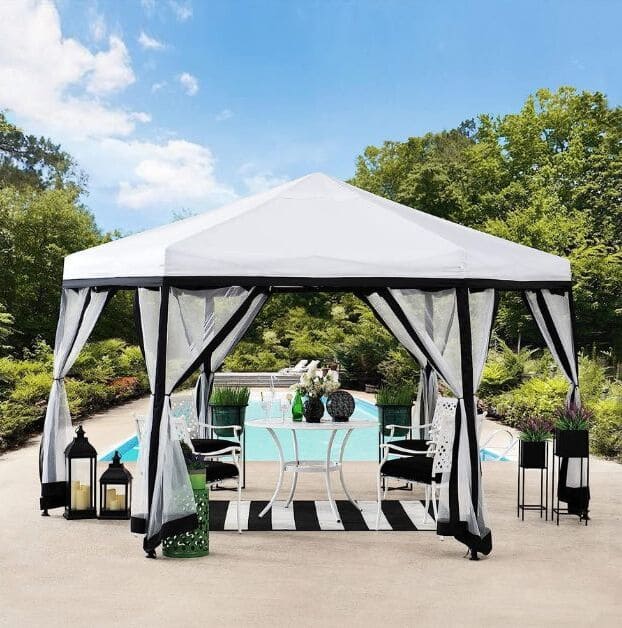
Canopy gazebos are outdoor shelters that have a roof held up by poles. They’re easy to put together and take apart, so you can move them around. You can use them for outdoor events like parties or picnics.
They keep you in the shade and dry when it’s sunny or rainy. Canopy gazebos come in different shapes and sizes, and you can make them from different materials like canvas or vinyl.
Some canopy gazebos have extra things like mosquito nets or side panels to help you stay safe from insects or wind. If you want an outdoor shelter that’s easy to use and carry, a canopy gazebo is a great idea.
5. Four-season gazebos
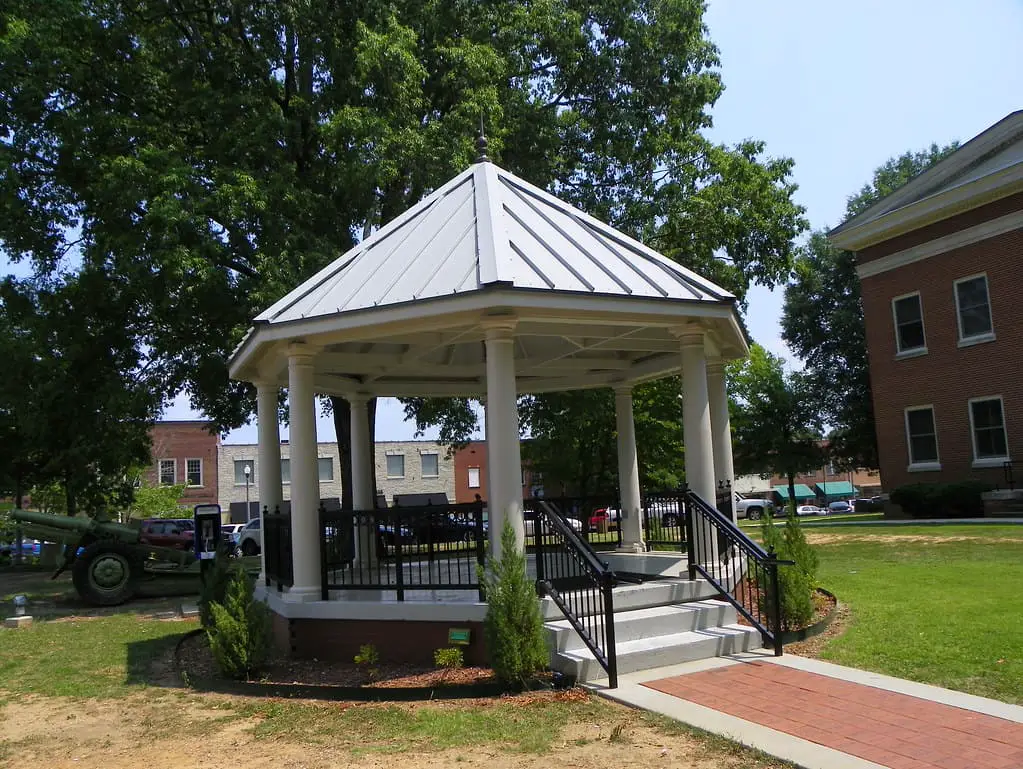
Four-season gazebos are outdoor structures that are designed to be used all year round, no matter the weather.
They are made from strong materials that can withstand harsh weather conditions like snow, wind, and rain.
Four-season gazebos are usually enclosed and have additional features like insulation, heating, and ventilation systems, which make them comfortable during cold months.
They can be used for different purposes such as outdoor living spaces, dining areas, or even as a workspace. If you want to make use of your outdoor space all year round, then a four-season gazebo is a good choice.
Materials
When selecting a gazebo, the materials used in its construction are an essential consideration. Common materials used in gazebo construction include wood, metal, vinyl, and fabric. Wood gazebos are durable and can be customized with different stains or paints to match the surrounding decor. Metal gazebos are typically more affordable than wood and offer a sleek and modern look.
Vinyl gazebos are low-maintenance and resistant to the elements, while fabric gazebos are lightweight and portable. The choice of material will depend on your style preferences, budget, and intended use of the gazebo.
1. Wood
If you look around your outdoor living area, you might notice a lot of things made from wood, like your patio furniture and trees. Wood is a great material for outdoor use because it blends in with nature and is calming to be around.
Wood also has many practical benefits for outdoor use. It is strong and long-lasting, requires minimal maintenance, and comes in many different textures and finishes, such as maple, teak, and oak. Additionally, wood is non-conductive, which means it does not conduct electricity easily, making it a safe material to use outdoors.
2. Fabric
Fabric is a versatile material that can be used for outdoor structures such as gazebos. There are various types of fabrics to choose from, including polyester, canvas, and vinyl. Fabric gazebos are typically lightweight and easy to set up and take down, making them a popular choice for outdoor events and activities.
Fabric gazebos also come in various sizes and shapes, making them a flexible option for different outdoor spaces.
They can be designed with additional features such as curtains, screens, or mosquito netting, making them a more comfortable and practical choice for outdoor living. If you’re looking for a lightweight and adaptable option for your outdoor living space, a fabric gazebo may be a perfect choice.
3. Metal
Metal is a popular material for outdoor use in gazebos and other structures. It is durable and long-lasting and can withstand harsh weather conditions. Metal gazebos are available in various types of metal, such as aluminum, steel, and wrought iron.
Aluminum gazebos are lightweight and easy to maintain, making them ideal for portable structures. Steel gazebos are strong and sturdy, and are often used for permanent installations.
Wrought iron gazebos are durable and elegant, with intricate designs that can add a touch of sophistication to any outdoor space. Metal gazebos can be designed to suit a range of styles, and can be customized with various features, such as curtains or mosquito netting.
If you want a durable and low-maintenance option for your outdoor living area, a metal gazebo might be a good choice.
4. Vinyl
Vinyl is a type of material that is commonly used in building and construction. It is often used as an alternative to wood or metal because it is affordable and durable. Vinyl is waterproof and resistant to UV radiation, stains, and scratches, making it easy to maintain.
It is commonly used in the construction of outdoor structures, such as gazebos, due to its weather-resistant properties. Vinyl is available in a range of colors and styles, making it a versatile material for creating a unique and modern look.
If you are looking for an affordable and long-lasting option for your outdoor living space, a vinyl gazebo may be a good choice.
Size and Shape
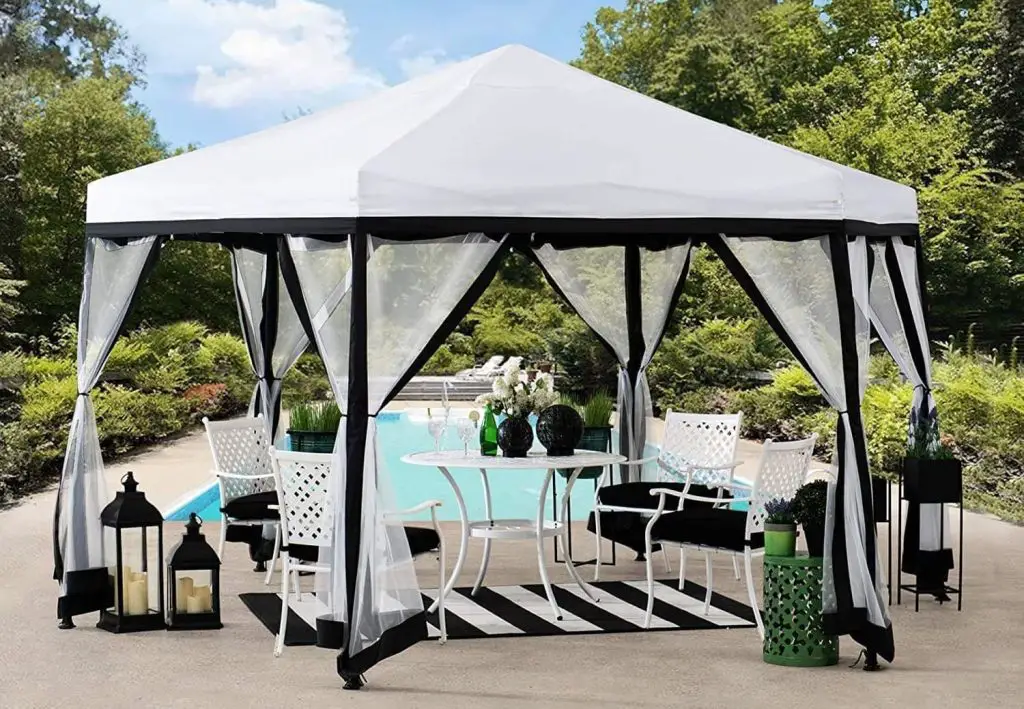
When choosing a gazebo, it’s important to consider the size and shape that will fit in your outdoor space. Gazebos come in different shapes and sizes, from small to large.
The size you choose should depend on the intended use and the available space in your backyard.
For example, a small gazebo may be suitable for a cozy get-together, while a larger one may be necessary for a bigger outdoor event.
The shape of the gazebo can also impact its use and appearance. A rectangular gazebo is more formal, while a circular or octagonal gazebo is more casual. Choosing the right size and shape for your gazebo can help you make the most of your outdoor space and create an inviting area for socializing, relaxing, or dining with loved ones.
Square gazebos
Square gazebos are outdoor structures with a square-shaped floor plan and a roof supported by pillars. They are one of the most popular shapes for gazebos because of their classic and timeless design. Square gazebos can be small or large and can be made from various materials like wood, metal, vinyl, or fabric.
They are ideal for outdoor dining or as a focal point in a garden or backyard. Square gazebos can be customized with additional features such as lighting, curtains, or even built-in benches. If you’re looking for an elegant and practical way to enhance your outdoor living space, a square gazebo could be a perfect choice.
Rectangular gazebos
Rectangular gazebos are outdoor structures with long and narrow shapes. They are typically designed with a rectangular floor plan and a pitched roof. Rectangular gazebos are popular for formal occasions, as their shape provides a more traditional and elegant look.
They offer ample space for seating and dining and can be used to host outdoor events or even as a workspace.
Because of their shape, rectangular gazebos can also be easily incorporated into a backyard or garden design. They come in a variety of materials and styles, making it easy to find one that matches your home’s architecture and your personal taste.
Hexagonal or Octagonal gazebos
Hexagonal or octagonal gazebos are outdoor structures that have six or eight sides. These gazebos are designed to provide an open and airy space with a unique, eye-catching shape that can add visual interest to any outdoor area.
Their shape and structure make them a great choice for a more casual and relaxed atmosphere, such as a backyard barbecue or family gathering.
They also provide an ideal space for outdoor dining, lounging, or enjoying a cup of coffee or tea while taking in the beauty of your garden or backyard. Hexagonal or octagonal gazebos are available in various sizes and styles, making them a versatile and attractive addition to any outdoor space.
Oval gazebos
Oval gazebos are outdoor structures that have an elongated shape and can make your outdoor living space look fancy. They are usually made of different materials such as wood, metal, and vinyl, and come in various sizes.
Oval gazebos are roomy and have more space than circular or square gazebos, making them great for big groups and events.
They can be used for many outdoor activities like eating, relaxing, or exercising. Oval gazebos can give your garden a unique and sophisticated look and provide an excellent place for spending time with family and friends.
Size considerations based on purpose and available space

When choosing a gazebo, it’s essential to consider its purpose and the available space in your outdoor area. For instance, if you plan to use the gazebo for outdoor dining or entertaining, it should be big enough to accommodate all your guests comfortably.
On the other hand, a smaller size might be more appropriate if you want a private retreat for relaxing.
It’s also crucial to consider the available space in your yard, as the gazebo should fit well and not overcrowd the area. Make sure to measure the area carefully and choose a gazebo that’s proportional to the space. This way, your gazebo will serve its purpose and enhance the beauty of your outdoor space.
Features
A gazebo can be a great addition to your outdoor area. You can customize it by adding some features to make it more comfortable and functional. Some popular features that you can consider include lighting for use during the night, curtains or screens to keep the bugs out, benches or seats to provide more seating options, and decorative items such as weather vans or cupolas.
You can even add extra amenities like fans, heaters, and sound systems to make it more enjoyable. Adding the right features can create a comfortable and peaceful area for relaxation, dining, or entertainment in your garden or backyard.
Flooring
Choosing the right type of flooring is important when it comes to gazebos. It can affect how your gazebo looks and how well it works. You can choose from different flooring options, including wood, composite, stone, and concrete. Wood flooring can make your gazebo look warm and natural.
Composite flooring can be sturdy and need less maintenance. Stone or concrete flooring can be more stable and long-lasting. You should choose the flooring that fits your needs and style and complements the design of your gazebo.
Roofing
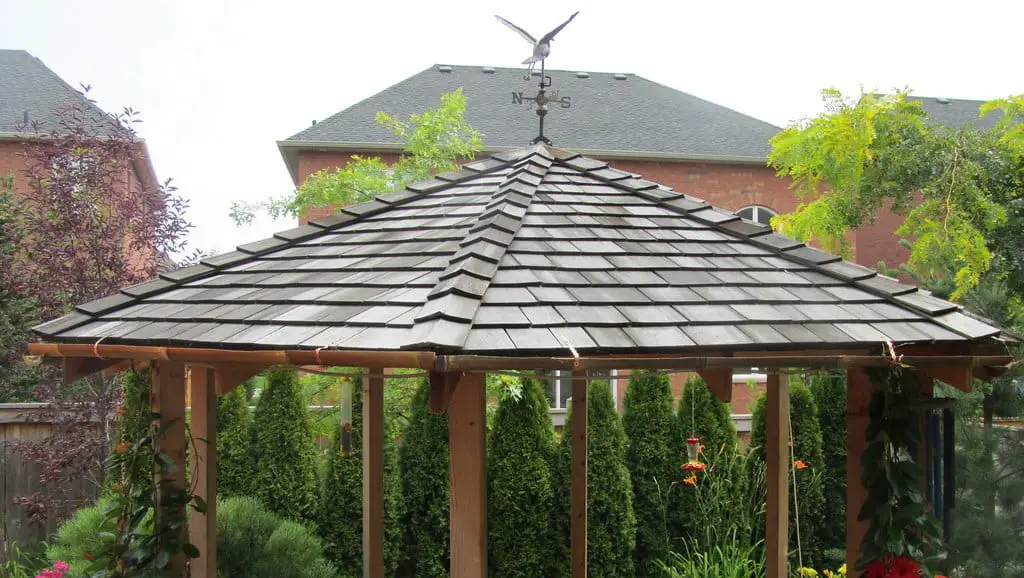
The roof is important for a gazebo, as it protects from the weather and adds to its style. You can choose from roofing materials, such as shingles, metal, thatch, and polycarbonate.
Shingles give a classic look, while metal is durable. Thatch creates a tropical feel, and polycarbonate lets in natural light and provides sun protection.
When choosing the roof for your gazebo, consider the style of your gazebo, the weather where you live, and your personal preference.
Walls
Walls are not always needed for gazebos, but they can be useful for protecting you from the weather, providing more privacy, and making the space feel cozier. You can choose from different types of walls, such as screens, curtains, glass, and lattice.
Screens and curtains can keep insects out while allowing fresh air to come in, while glass is a more long-lasting and weather-resistant option.
Lattice walls let more air through, while still giving some privacy. The type of walls you select will depend on what you need, how you want the space to look, and how you plan to use it.
Screens and netting
Screens and netting are useful to add to gazebos. They keep away insects and pests while allowing fresh air to come in. They can be made of different materials, such as mesh or polyester, and can be attached to the walls or roof of the gazebo.
Some gazebos already come with screens or netting, while others may need them to be added separately. Screens and netting can make your outdoor space more comfortable and enjoyable, especially during the warmer months when bugs can be problematic.
Lighting and Electricity
Lighting and electricity are essential things to consider when setting up your gazebo. Lighting can make your gazebo look pretty and help you see when it’s dark. Some popular lighting choices are string lights, lanterns, and lights that are built into the gazebo. Electricity is important if you want to use your gazebo for cooking or other power-related activities.
You can set up electrical outlets and wiring to power appliances, fans, or other devices. When planning your gazebo, you should consider your lighting and electricity needs, where to get power from, and how much it will cost.
Hanging lights in the gazebo is fun but with the right knowledge, If you want to hang lights then no worry. We have covered it in our last article.
Furniture and accessories
Adding furniture and accessories to your gazebo can make it more comfortable and beautiful. You can add chairs, benches, tables, and hammocks to your gazebo for seating options. You can also add cushions, pillows, rugs, and outdoor lighting to make the space more inviting.
When choosing furniture and accessories, you should ensure they are durable and suitable for the weather conditions in your area. It is also important to consider the style and colors of your gazebo so that everything matches and looks good together.
Maintenance and Care
Taking good care of your gazebo is important to keep it in good condition and make it last longer. You can do this by regularly cleaning, sealing, and painting it to protect it from the weather.
The type of material your gazebo is made of will determine the specific cleaning and maintenance methods needed. For example, wooden gazebos may need a waterproofing agent to prevent rot, while metal gazebos may need rust-proofing.
Regularly checking the gazebo’s roof, walls, and flooring can help you find and fix any problems before they become more serious. By taking good care of your gazebo, you can enjoy it as a functional and beautiful part of your outdoor space for many years.
Cleaning and upkeep
Keeping your gazebo clean and maintained is essential for ensuring its longevity and attractive appearance. Regular cleaning helps prevent the buildup of dirt, debris, and other harmful materials that can cause damage over time. It’s important to follow the manufacturer’s cleaning instructions based on the gazebo’s material.
In addition, upkeep tasks such as inspecting and repairing structural components, maintaining landscaping, and checking on lighting and electrical systems should be done regularly. By taking care of your gazebo, you can enjoy it for many years to come.
Repairs and replacements
Gazebo repairs and replacements are important to keep your outdoor space in good condition. As time passes, some parts of the gazebo may get worn out, damaged, or broken down. Addressing the issues as soon as possible is crucial to avoid more significant problems. Repairs may involve fixing small or significant issues like replacing damaged roof shingles or structural components.
Sometimes, entire systems like lighting or electrical systems may need replacement to improve performance and safety. By staying on top of gazebo repairs and replacements, you can ensure it continues to be a safe and functional space for your outdoor living.
Budget Considerations
If you’re planning to build a gazebo, there are some important things to keep in mind when it comes to your budget. You’ll need to think about the size of the gazebo you want and the materials you plan to use. Some materials, like wood or metal, may be more expensive than others. You’ll also want to consider any extra features you might want, like lighting or screens to keep out bugs.
It’s a good idea to make a budget and stick to it as closely as possible to avoid overspending. With careful planning and consideration, you can build a beautiful gazebo that fits your budget.
Cost of materials and construction
If you’re considering building a gazebo, you should know that the cost of materials and construction can vary widely. The cost of materials will depend on what you choose to use – wood, metal, and vinyl are all popular options.
The cost of construction will depend on the size of the gazebo, as well as any additional features you want to include, like screens or lighting. If you’re handy with tools, you may be able to save money by building the gazebo yourself but keep in mind that this can be a challenging project.
If you’re uncomfortable building it yourself, you’ll need to hire a contractor, which will add to the cost. Before you start building, it’s a good idea to make a budget and get contractors’ estimates to ensure you can afford the gazebo you want.
Related Article: Your Complete Guide to Gazebo Costs and Design
Optional features and upgrades
A gazebo is a small outdoor structure, usually with a roof and open sides. Optional features and upgrades refer to extra things that can be added to the basic gazebo design to make it more comfortable or convenient. These could include things like benches or chairs, lighting fixtures, screens or curtains for privacy, or even a fireplace or heating system.
Optional features and upgrades are not necessary for the gazebo to function, but they can make it a more enjoyable and useful space for people to spend time in.
Maintenance and repair costs
Keeping a gazebo in good condition can be expensive. This includes money spent on fixing it if something goes wrong, and also for regular upkeep to prevent problems from happening. These expenses are known as maintenance and repair costs.
FAQs
Q.1 How do I choose a good gazebo?
When you’re picking out a gazebo, two important things to think about are how much money you want to spend and how big you want it to be. Usually, more giant gazebos cost more money. It’s a good idea to decide on a budget beforehand, but you also need to consider how much space you have and what size the gazebo would fit nicely in it.
Q.2 What is the most popular size of a gazebo?
A gazebo that is 3 meters by 3 meters is a popular size for small to medium-sized parties and events. This site is also good for gardens or commercial spaces because it is square-shaped and fits well.
Q.3 Which gazebo is better metal or wood?
A gazebo made of metal is more robust and can be used in many different ways compared to a wooden gazebo. It’s also easier to assemble and doesn’t need as much work to keep it in good condition. This stylish building is great to use as a separate garage and provides extra shade and protection wherever you want it.
Conclusion
The conclusion of a Gazebo Buying Guide would depend on the specific guidelines in question, as many are available online and in print. However, a good Gazebo Buying Guide should generally provide recommendations and advice for selecting the right gazebo based on a buyer’s needs and budget. It should cover factors such as size, material, style, and features and help buyers evaluate the different options available.
Ultimately, the conclusion of a Gazebo Buying Guide is likely to encourage buyers to consider their requirements carefully and do their research before making a purchase, to select a high-quality and long-lasting gazebo that will provide value and enjoyment for years to come.
After reading this comprehensive guide, we hope you will be well aware after Gazebo buying guide. If you have any questions, feel free to comment below!

